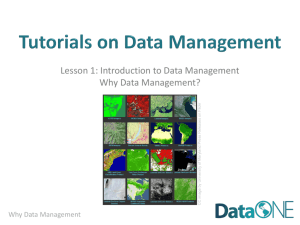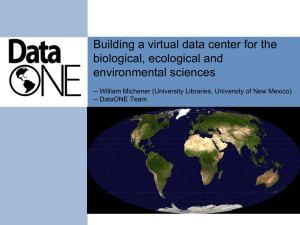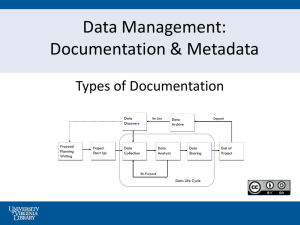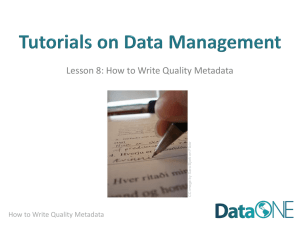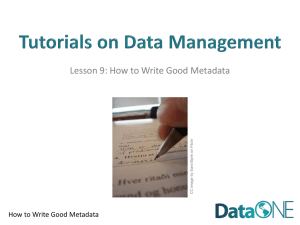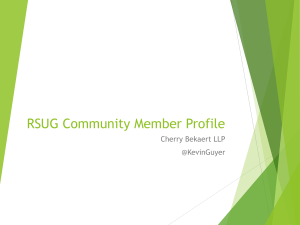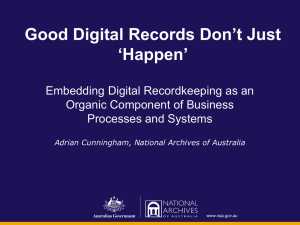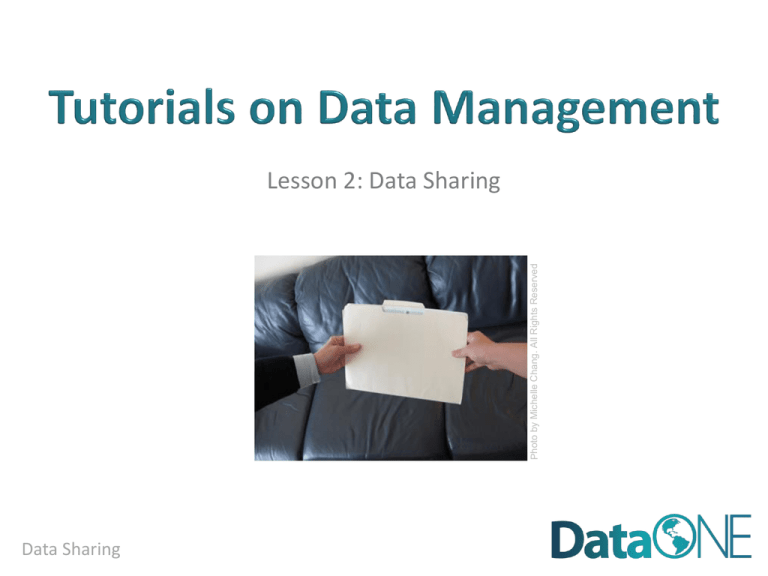
Photo by Michelle Chang. All Rights Reserved
Lesson 2: Data Sharing
Data Sharing
Data Sharing Within the Data Lifecycle
Value of Data Sharing
Concerns About Data Sharing
Methods for Making Data Sharable
CC image by Kevin
Byron on Flickr
•
•
•
•
Data Sharing
• After completing this lesson, the participant will be able to:
discuss data sharing considerations within the data life cycle
recognize the benefits of sharing scientific data
address concerns about sharing data
outline a process for making data sharable
o identify mechanisms for sharing data
CC image by PictureYouth on Flickr
o
o
o
o
Data Sharing
• Data sharing should be
addressed throughout
Analyze
the data life cycle1
Plan
Collect
Integrate
Assure
Discover
Describe
Preserve
Data Sharing
• Several stages require critical attention to ensure effective
data sharing
Describe
document the data content, character and
process
Deposit
store the data in a location from which it can be
accessed
Preserve
select storage formats and media with long term
use in mind
Discover
publish information about the data so that
others can find it
Data Sharing
For the benefit of:
o the public
o the research sponsor
o the research community
o the researcher
Data Sharing
CC image by Jessica Lucia on Flickr
Data sharing requires effort, resources, and faith in others.
Why do it?
A better informed public yields better decision making with
regard to:
Data Sharing
CC image by falonyates on Flickr
o Environmental and economic planning
o Federal, state, and local policies
o social choices such as use of tax dollars and education options
o personal lifestyle and health such as nutrition and recreation
• Organizations that sponsor research must maximize the
value of research dollars
• Data sharing enhances the value of research investments by
enabling:
o verification of performance metrics and outcomes
o new research and increased return on investment
o advancement of the science
o reduced data duplication expenditures
Data Sharing
Access to related research enables community members to:
CC image by Lawrence Berkeley National
Laboratory on Flickr
o build upon the work of others and further, rather than repeat, the
science4
o perform meta analyses that cannot be performed with individual
datasets or laboratories5
o share resources and perspectives so that comprehension is expanded
and enhanced5
Data Sharing
Access to related research enables community members to
(cont’d):
o increase transparency, reproducibility and comparability of results5
o expand methodology assessment, recommendations and
improvement6
o educate new researchers as to the most current and significant
findings6
Data Sharing
Scientists that share data gain the benefit of:
CC image by SLU Madrid Campus
on Flickr
o research sponsor recognition as an authoritative source and wise
investment
o improved data quality due to expanded use, field checks, and
feedback
o greater opportunity for data exchange
o improved connections to scientific network, peers, and potential
collaborators
Data Sharing
CC image by CyberHades on Flickr
Even if the value of data sharing is recognized, concerns
remain as to the impacts of increased data exposure.
Data Sharing
Concern
inappropriate use due to
misunderstanding of research
purpose or parameters
security and confidentiality of
sensitive data
lack of acknowledgement / credit
loss of advantage when competing
for research dollars
Data Sharing
Solution
Concern
Solution
inappropriate use due to
misunderstanding of research
purpose or parameters
metadata
security and confidentiality of
sensitive data
metadata
lack of acknowledgement / credit
metadata
loss of advantage when competing
for research dollars
metadata
Data Sharing
Concern
Solution
inappropriate use due to
misunderstanding of research
purpose or parameters
provide rich Abstract, Purpose,
Use Constraints and Supplemental
Information where needed
security and confidentiality of
sensitive data
• the metadata does NOT
contain the data
• Use Constraints specify who
may access the data and how
lack of acknowledgement / credit
specify a required data citation
within the Use Constraints
loss data insight and competitive
advantage when vying for
research dollars
create second, public version with
generalized Data Processing
Description
Data Sharing
Step One:
Create robust metadata that is discoverable
o specify geography and time periods
o use discipline specific theme, place and temporal keywords, thesauri,
and ontologies
o describe attributes
o include links to associated data catalogues, data downloads, project
websites, etc.
Data Sharing
Step Two:
Include archival and reference information
o properly formatted data citations for the data and all sources
o Universally Unique Identifiers (UUID) that uniquely identify your data
and help to link the data with the metadata
See the DataONE unique identifier guidance at:
http://mule1.dataone.org/ArchitectureDocs-current/design/PIDs.html
Data Citation Example: Sidlauskas, B. 2007. Data from: Testing for unequal rates of
morphological diversification in the absence of a detailed phylogeny: a case study from
characiform fishes. Dryad Digital Repository. doi:10.5061/dryad.20
Data Sharing
Step Three:
Have data contributors review your metadata to ensure validity
and organizational ‘correctness’?
o are the processes described accurately?
o are all contributions adequately identified?
o has management reviewed the product and documentation?
o is the funding organization properly recognized?
Data Sharing
Step Four:
Publish your metadata via:
Data Portals / Clearinghouses
Federal
o geodata.gov
o data.gov
o USGS Core Science Metadata Clearinghouse
(mercury.ornl.gov/clearinghouse)
Communities of Practice
o Knowledge Network for Biodiversity (KNB) Data Portal
o Long Term Ecological Research (LETR) Network Data Portal
Data Sharing
Step Four:
Publish your metadata and/or data via: (cont’d)
Other Online Resources:
o
o
o
o
Data Sharing
Project and/or Program websites
Links within online lessons and outreach products
Web-accessible folders (WAF)
Community or Public Cloud
• Document and publish data using standards
• Promote data use via presentations and meetings
• Solicit feedback from data users and address identified
issues
• Monitor publications and websites for data use and address
misapplications
Data Sharing
Data Sharing
CC image by Andrew Mccluskey on Flickr
• In 2003, a group of scientists from the National Institutes
of Health, the Food and Drug Administration, drug and
medical imaging industries, universities, and nonprofit
groups joined in a collaborative effort to find the
biological markers that show the progression of
Alzheimer’s disease in the human brain.
• The goal of this project was to do research on a massive
scale that would involve sharing and making accessible all
the data uncovered to anyone in the world with a computer.
• Dr. John Trojanowski an Alzheimer’s researcher at the
University of Pennsylvania stated, “It’s not science the way
most of us have practiced it in our careers. But we all
realized that we would never get biomarkers unless all of
us parked our egos and intellectual-property noses outside the door and
agreed that all of our data would be made public immediately.”
• http://www.nytimes.com/2010/08/13/health/research/13alzheimer.html
• Data sharing adds value to the data
• It is the responsibility of the researcher to share their data
• Metadata supports data accountability, liability, and
usability
• Sponsors expect, some require, data to be shared
• Data sharing is essential to the advancement of science
Data Sharing
1.
2.
3.
4.
Inter-university Consortium for Political and Social Research (ICPSR), ICPSR
Guide to Data Preparation and Archiving: Best Practice Throughout the Data
Life Cycle (ICPSR, 2009;
http://www.icpsr.umich.edu/files/ICPSR/access/dataprep.pdf). [4th Edition]
Australian Bureau of Statistics - National Statistical Service (ABS-NSS), A good
practice guide to sharing your data with others (ABS-NSS, 2009;
http://www.nss.gov.au/nss/home.nsf/NSS/E6C05AE57C80D737CA25761D002
FD676?opendocument). [Vers. 1]
H.A. Piwowar, A new task for NSF reviewers: Recognizing the value of data
reuse. ResearchRemix vers. May 28, 2011
(http://researchremix.wordpress.com/2011/05/28/dear-nsf-reviewers/).
[blog posting of draft]
H.A. Piwowar, M.J. Becich, H. Bilofsky, R.S. Crowley, Towards a Data Sharing
Culture: Recommendations for Leadership from Academic Health Centers.
PLoS Med. 5(9), e183 (2008), doi:10.1371/journal.pmed.0050183. [on behalf
of the caBIG Data Sharing and Intellectual Capital Workspace]
Data Sharing
5.
6.
7.
8.
J.L. Teeters, K.D. Harris, K.J. Millman, B.A. Olshausen, F.T. Sommer, Data
Sharing for Computational Neuroscience. Neuroinform (2008), DOI
10.1007s12021-008-9009-y.
[http://redwood.berkeley.edu/fsommer/papers/teetersetal08.pdf]
National Institute of Health (NIH) “NIH Data Sharing Policy and
Implementation Guidelines” (NIH, Washington D.C., 2003,
http://grants.nih.gov/grants/policy/data_sharing/data_sharing_guidance.htm
).
R. Geambasu, S.D. Gribble, H. M. Levy, "CloudViews: Communal Data Sharing
in Public Clouds" In Proceedings of the First USENIX Workshop on Hot Topics
in Cloud Computing (HotCloud), San Diego, USA, June 2009. [Paper: PDF;
Presentation: PPT, PDF]
J. Niu, “Reward and Punishment Mechanisms for Research Data Sharing”.
IASSIST Quarterly, Winter (2006).
Data Sharing
9.
C.L. Borgman, “Research Data: Who will share what, with whom, when, and
why?” in Proceedings of the China-North American Library Conference, Beijing
, September 2010 (http://works.bepress.com/borgman/238/).
Data Sharing
The full slide deck may be downloaded from:
http://www.dataone.org/education-modules
Suggested citation:
DataONE Education Module: Data Sharing. DataONE. Retrieved
Nov12, 2012. From
http://www.dataone.org/sites/all/documents/L02_DataSharing.
pptx
Copyright license information:
No rights reserved; you may enhance and reuse for
your own purposes. We do ask that you provide
appropriate citation and attribution to DataONE.
Data Sharing

